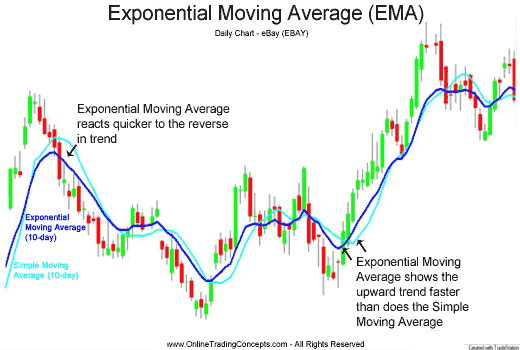Moving Averages

we will discuss three types of moving averages and how to
use moving averages to identify the
direction of a trend how they can be
used to enter an Exit trade and
finally how to trade moving average
crossovers to determine the direction of
a trend using a moving average you must
take into account the set time period we
touched on this briefly in the last
video where we showed you the most
commonly used time periods when
analyzing short term midterm and long
term trends but why is it important to
be aware of the time period of the
moving average in this chart where we
place a 20 period simple moving average
by clicking the indicator icon and
setting the time period to 20 we can
clearly see that it indicates an uptrend
yet when we place a 60 period simple
moving average in the same way we see
that it shows the price in a range with
no clear upward or downward trend the
difference in the direction of the trend
portrayed by the moving average is due
to the time period shorter period moving
averages are faster at generating
signals and changes in the price of the
instrument will be reflected more
quickly the longer period moving average
will react to price changes much more
slowly but will generally provide more
reliable trading signals as a trader
moving averages will help you decide
which way to trade by looking at whether
the price is above or below the moving
average line in this chart the price is
above the moving average line and acts
the support you could buy and enter a
long position when the price pulls back
to the moving average line you could
then place your stop-loss underneath the
moving average
here we can see the opposite the price
is below the moving average and acts as
resistance you could then enter a sell
order when the price retraces to the
moving average line and place your
stop-loss above the moving average the
interesting thing about moving averages
is that they can be used alone or in
combination with other moving averages
so when you place two moving averages on
one chart with different periods
reflecting a short-term and a
longer-term trend in price you have the
opportunity to trade moving average
cross overs they can be used to
determine when a trend has changed
direction let's show you what we mean on
a daily chart for the pound US dollar we
will now place a 10 period simple moving
average and a 20 period simple moving
average when a short appeared moving
average crosses above a longer period
moving average you can signal that the
trend is changing direction to the
upside and it may be a good time to buy
when a shorter period moving average
crosses below a longer period moving
average this is considered bearish a
signal that the trend may be changing
towards the downside and it may be a
good time to sell no matter which two
time periods you use this principle will
remain the same to recap a moving
average is a lagging indicator that can
help filter out the noise from random
price movements to see the average value
it can help identify the trend direction
determine support and resistance levels
and can help confirm a trend reversal
when looking at moving average
crossovers it is important to understand
the differences between the types of
moving averages and how to tailor the
time period to best fit the trend being
followed in order to gain the maximum
benefit from this indicator
thank you for reading this tutorial on